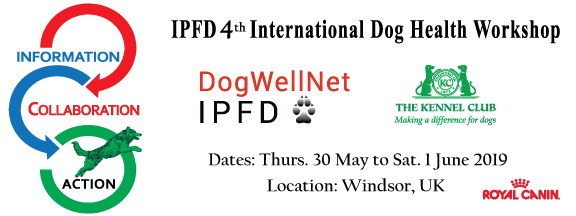Why do people choose the dogs they do - and what is the impact on dog health and welfare?
Why do people choose the dogs they do and how does that influence the health and welfare of dogs?
What do we know – and don’t know – about these complexities inform our efforts to educate people and safeguard the well-being of our canine companions?
A new open access article is an excellent, comprehensive review of published evidence about factors influence dog acquisition:
Acquiring a Pet Dog: A Review of Factors Affecting the Decision-Making of Prospective Dog Owners
By Katrina E. Holland, Dogs Trust. Animals 2019, 9(4), 124
- See Attached (internal): Acquiring a Pet Dog - A Review of Factors Affecting the Decision-Making of Prospective Dog Owners
The ‘Simple Summary’:
“Each year, many people around the world get a pet dog. With so many different types and breeds of dogs available, and a variety of sources from which to obtain a dog, the process of getting a dog can be complex. The decisions involved in this process are likely influenced by a variety of human- and dog-related factors and this review explores the factors that appear to be the most important.”
The paper contains a wealth of information and extensive review of research on the topic.
Key points:
- “Across the stages of dog acquisition there is potential for practices that may promote or compromise canine welfare.”
- “those working in the canine welfare sector, [must] refine their ability to identify and respond to trends in the behavior of potential dog owners.”
- “The most widely reported factors associated with acquisition behavior include: the dog’s physical appearance, behavior and health; social influences, such as trends in the popularity of certain breeds; demographic and socioeconomic factors; and the owner’s previous ownership experience.”
- “Overall, the research discussed in this paper highlights that complex interactions likely underpin the various factors that might influence prospective owners’ motivators and behaviors.”
COMPLEX! That is the real take home message.
 Many in the dog world have been trying to get the message out to people about the risks for poor health and compromised welfare for certain breeds and similar concerns based on the sources of dogs. However, for those from welfare and veterinary backgrounds especially, it seems obvious that getting a healthy pet should be the number one priority. Much of the cited research makes it clear that – although the motivations are complex – health is not at the top of the list for many who are making the decision to get a dog. Even if people do ‘research’ or seek advice, it may not sway them from a deep-seated preference for a specific breed. This may be most marked for those with an affinity for brachycephalic breeds which may be based on their ‘infantile” appearance, the dogs’ strong human attachment.
Many in the dog world have been trying to get the message out to people about the risks for poor health and compromised welfare for certain breeds and similar concerns based on the sources of dogs. However, for those from welfare and veterinary backgrounds especially, it seems obvious that getting a healthy pet should be the number one priority. Much of the cited research makes it clear that – although the motivations are complex – health is not at the top of the list for many who are making the decision to get a dog. Even if people do ‘research’ or seek advice, it may not sway them from a deep-seated preference for a specific breed. This may be most marked for those with an affinity for brachycephalic breeds which may be based on their ‘infantile” appearance, the dogs’ strong human attachment.
I have said in presentations and articles that if a consumer's strongest desire is for, e.g. a dog with a specific appearance, with specific behavior traits, maybe even related to the need for intense care-giving ... then stressing the importance of health may not be effective. I liken it to, e.g, telling a young person who is intent on acquiring a fast, loud, trendy car that they should, first and foremost, be looking for a vehicle that has low fuel consumption. The information being provided may be about a factor not even on their radar.
 These challenges and issues all underlie our focus at the 4th International Dog Health Workshop (IDHW) we are combining attention to addressing issues related to Extremes and Exaggerations (of conformation) with identifying communication strategies to promote human behavior change.
These challenges and issues all underlie our focus at the 4th International Dog Health Workshop (IDHW) we are combining attention to addressing issues related to Extremes and Exaggerations (of conformation) with identifying communication strategies to promote human behavior change.
At the 4th IDHW we also have a theme on Supply and Demand, which is integrally involved with/influenced by these same issues. Even if people do adequate research on ideal sources of acquisition for dogs (e.g. approved breeders) they may not actually access the better sources due to, if not impulse buying, at least a desire for a timely purchase. An additional concern is that consumers may be oblivious as to the actual source of their dog. Is the ‘breeder’ - selling online or kindly offering to meet you somewhere to save you trouble finding their kennel - a good, health-conscious breeder or a representative of a puppy mill? Have the dogs at shelters/rescues been purchased from auctions or puppy farms – with good intention, perhaps – but with what ramifications.? How do you determine a community-based, good quality rescue from what is essentially a commercial re-homing business? And again, source might not be high on that decision-making list for many consumers, perhaps more a matter of convenience.
We know that the best-qualified and highest quality breeders cannot come close to supplying demand. In some countries, e.g. Sweden, rules and societal pressure for responsible dog ownership exist and are enforced, and welfare is very high. In general, people do not acquire pets if they cannot fulfill the criteria. Elsewhere? As there has been an increased acknowledgement of dogs being a ‘member of the family’ and ‘good for human health and welfare’, in many countries the pet industry, veterinarians, and even welfare groups have pushed for increased dog ownership. This may have been with good intentions, but an increase in demand, without a consideration of supply, has supported the increase in commercial breeding, questionable online marketing, illegal or uncontrolled trade/importation and even proliferation of sources which are seemingly impossible to regulate.
COMPLEX!
The author of the attached paper has done a good job covering all the possible stages of decision-making involved with acquiring a dog, but admits that even the extensive literature has limitations. There are so many factors – attitudes, social, physical – about the people – about the dogs, etc. – that no studies have been able to truly address the complete picture. Given the complexity, it seems clear that effective education and communication will never be easy, straightforward or ‘one-size fits all’. To effect human behavior change the messages must be targeted based on specific breeds (e.g. brachycephalic breed acquisition seems different than for other breeds), consumer characteristics (e.g. age, attitudes and other factors), and perhaps region, country and more.
It is obvious that this will need collective and collaborative actions across many stakeholder groups and there will no doubt be specific actions identified at the 4th IDHW as we work together to enhance the health and welfare of dogs.
Thanks to Katarina Holland and Dogs Trust for this contribution to the literature on this complex topic.
Other resources:
Don't know or don't care? Presentation at Human Behaviour Change for Animals Conference 2016.
Don’t Know or Don’t Care_Bonnett_Sandoe_2016 HumanBehaviourChangeConference
Blog Disclaimer
The contents of this blog are for informational purposes only and represent the opinion of the author(s), and not that of the International Partnership for Dogs (IPFD). This is not intended to be a substitute for professional, expert or veterinarian advice, diagnosis, or treatment. We do not recommend or endorse any specific tests, providers, products, procedures, opinions, or other information that may be mentioned on, or linked to from this blog.
 Donate
Donate


0 Comments
Recommended Comments
There are no comments to display.